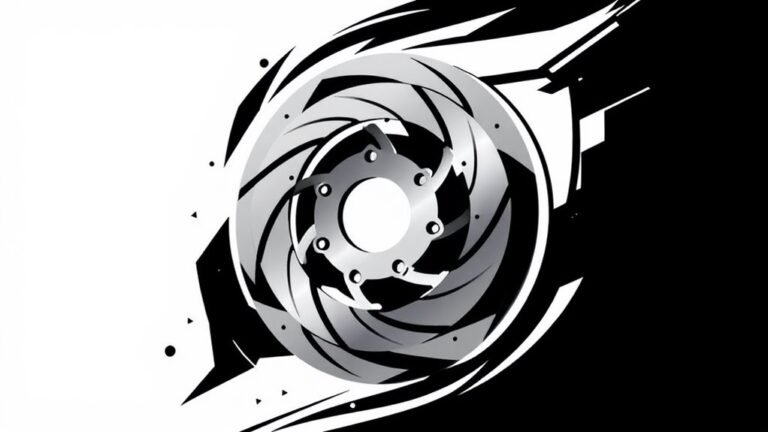Drilled and slotted rotors pack a punch when it comes to stopping power and handling, especially in wet conditions. They help release water and debris, making your brakes more effective. But hold on, there’s a catch! They can wear out faster and crack more easily than standard versions, leading to some maintenance headaches. If you enjoy thrilling drives, these rotors might fancy your ride, but watch for those pesky sounds. Curious about which rotor is right for you?
Main Points
- Drilled rotors enhance heat dissipation, improving braking performance but may compromise durability due to cracking risks around holes.
- Slotted rotors improve pad grip and water evacuation but can lead to quicker brake pad wear and increased maintenance costs.
- Both rotor types offer better wet weather performance, reducing hydroplaning risk and providing shorter stopping distances in challenging conditions.
- Initial costs for drilled and slotted rotors are higher, typically 20-50% more than standard rotors, with potential for increased long-term maintenance expenses.
- Aesthetic appeal is enhanced with these rotors, but they may generate noise during braking, which can escalate under heavy use.
Do They Improve Stopping Power?
Have you ever wondered if those fancy drilled and slotted rotors really make a difference when it comes to stopping power? Well, they actually do!
Drilled rotors help with heat dissipation, which means they keep your brakes cool during heavy use, helping maintain solid braking performance.
On the flip side, slotted rotors increase the brake pad’s grip, making it easier to stop quickly by clearing gas and dust.
When combined, these two designs balance heat control and improved grip, giving you the best stopping ability.
Nevertheless, it’s crucial to recognize that their effectiveness depends on your driving conditions.
Pro #1. Enhanced Wet Weather Performance
When it comes to driving in wet weather, having the right brakes can make a world of difference. Drilled rotors shine here, as their drilled holes help water escape quickly, reducing the risk of hydroplaning when you hit the brakes.
On the other hand, the slotted rotor design works its magic by channeling water and debris away from the rotor surface, ensuring the brake pad maintains a strong grip. Together, these features elevate brake pad bite, leading to shorter stopping distances compared to regular rotors.
For those who want a balanced approach, some rotors combine both drilled and slotted designs, providing excellent heat dissipation and water evacuation. This boost in wet weather performance certainly raises driver confidence during those tricky rainy days!
Con #1. Increased Rotor Wear Rate
Braking systems are like the unsung heroes of any vehicle, quietly working behind the scenes to keep drivers safe.
Nevertheless, when it comes to drilled and slotted rotors, the increased rotor wear rate can be a real concern. Those cool-looking holes and slots might help with performance, but they also create stress points that can lead to cracks under heavy braking.
Plus, slotted rotors can chew through brake pads faster, trapping debris and causing extra wear. This means more frequent replacements, which can hit the wallet hard.
In the long run, the increased rotor wear rate contributes to higher maintenance costs, making it essential for drivers to keep an eye on their braking systems for ideal safety and performance.
Pro #2. Reduced Brake Fade Risk
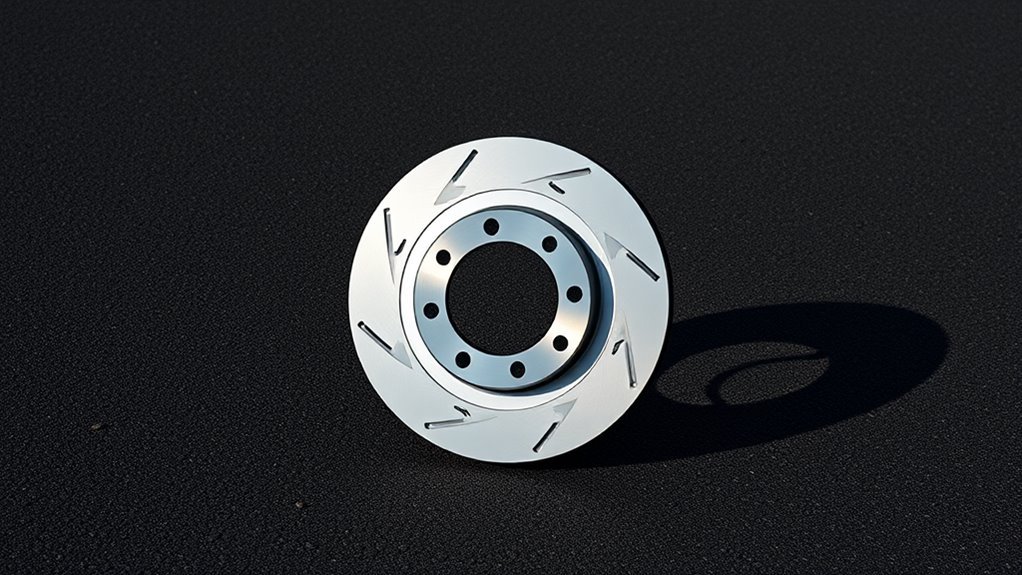
The thrill of smooth, reliable stops is a joy that drivers can appreciate, especially when it comes to the benefits of drilled and slotted rotors.
These groundbreaking designs help combat brake fade, which can turn a routine stop into a scary tale. Drilled rotors improve heat dissipation by letting air flow through their holes, while slotted rotors work to clear away gas and dust, ensuring the brake pads stay in touch with the rotor.
This combination keeps things cool under pressure! Plus, both types excel in wet conditions, channeling water away and helping to avoid hydroplaning.
With regular maintenance, drivers can keep their drilled and slotted rotors performing at their best, making every stop a safe one.
Con #2. Increased Susceptibility to Cracking
While drilled and slotted rotors certainly offer impressive advantages, they come with some serious drawbacks that shouldn’t be overlooked, especially when it comes to cracking.
Drilled rotors, known for their ability to cool quickly, are also more prone to cracking due to stress around those drilled holes. Imagine hitting the brakes hard during a wild ride; that’s when the risk skyrockets!
Over time, repeated braking can create tiny microfractures, threatening the rotor’s strength. Unlike their slotted counterparts, which handle stress better, drilled rotors require regular checks to catch any early signs of cracking.
Pro #3. Reduced Brake Dust Accumulation
When it comes to keeping those shiny rotors in tip-top shape, reduced brake dust accumulation is a game changer.
Drilled and slotted rotors feature clever design elements that help channel away gas and dust created during braking. The drilled holes enhance better airflow, cooling things down and minimizing brake dust buildup.
Meanwhile, the slots sweep away debris, keeping the rotor surface clean and improving braking efficiency. Less brake dust means longer-lasting brake pads and rotors, which is a win for everyone!
Regular maintenance and cleaning can further decrease that pesky brake dust, ensuring peak performance. Imagine your rotors looking good as new, all while giving you a smooth stop—talk about a sweet deal!
Con #3. Higher Cost Than Alternatives
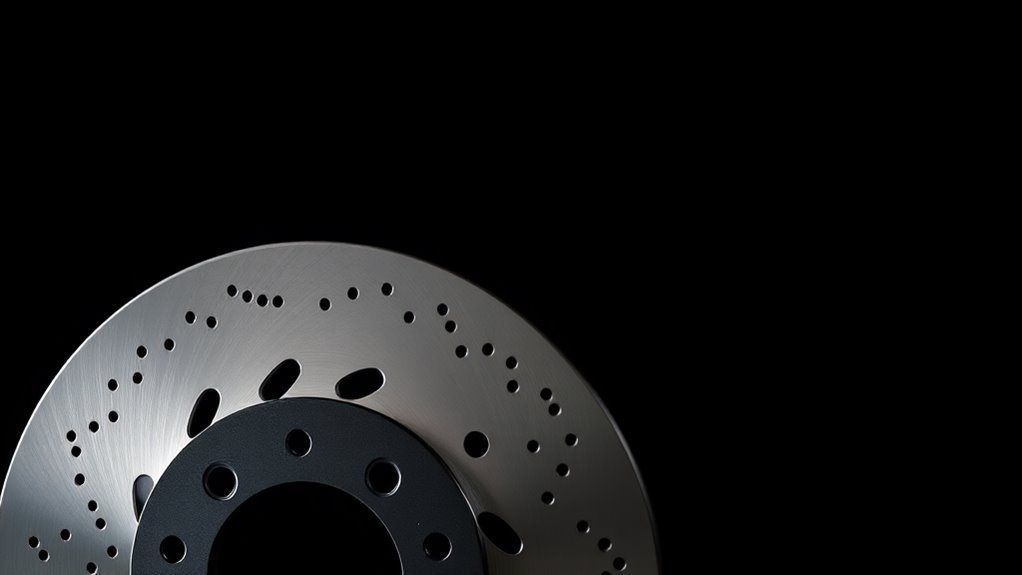
Investing in drilled and slotted rotors can feel like stepping into a premium car accessory store—exciting but a bit intimidating when it comes to the price tag.
These specialized rotors often come with a higher cost, generally 20-50% more than standard smooth rotors. While they promise improved performance, that price can give anyone pause.
Plus, slotted rotors might lead to increased maintenance costs over time, thanks to their tendency to wear down brake pads quicker.
So, while the initial investment is steeper, it’s essential to think about how they might save money in specific driving conditions, like high-performance racing, where their benefits shine.
Budgeting for both the upfront price and future maintenance can help steer this decision.
Pro #4. Improved Heat Dissipation Efficiency
Heat dissipation is like the superhero of braking performance, and drilled and slotted rotors are its trusty sidekicks.
Drilled rotors, with their nifty holes, really shine when it comes to getting rid of heat. They boost airflow during braking, allowing heat to escape, which helps keep rotor temperatures down and cuts down on brake fade. Studies show that these rotors can lower brake temperatures by up to 20% in high-performance situations.
While slotted rotors don’t quite match the heat-fighting powers of drilled rotors, they still help by letting gases and dust escape.
Together, these rotor designs can channel water away, ensuring that even when it’s wet, drivers can enjoy consistent performance and impressive heat dissipation.
Con #4. Potential for Thermal Warping
While drilled and slotted rotors are great at keeping things cool, they do have a bit of a dark side—thermal warping. This sneaky issue arises when rapid heat fluctuations during braking create uneven surface wear, which can seriously mess with braking performance.
Those drilled holes might help with cooling, but they also act like stress risers, making cracks more likely under extreme conditions, especially during high-speed driving. Drilled rotors are particularly at risk, thanks to the structural weaknesses those holes introduce.
Slotted rotors can help a bit here, distributing heat more evenly. To combat thermal warping, regular maintenance and proper bedding procedures are key, ensuring these rotors remain reliable and long-lasting.
Pro #5. Improved Pedal Feel Responsiveness
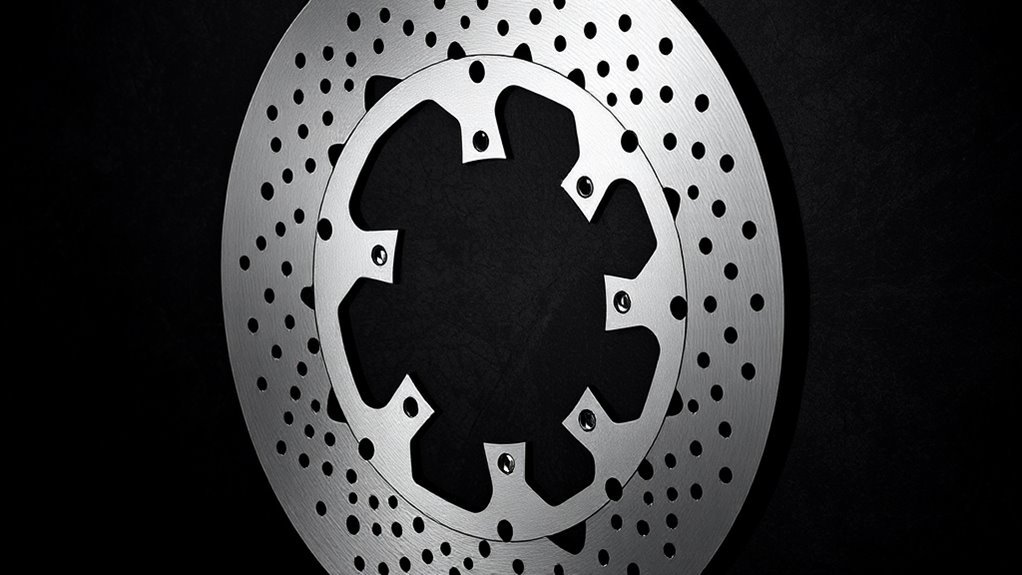
When it comes to braking, the feel of the pedal can make all the difference—especially for those who love a good thrill on the road.
Drilled rotors can improve responsiveness by reducing brake fade, making it easier for drivers to sense how hard they’re braking. This is essential for high-speed driving when every millimeter counts.
Nevertheless, they may feel a bit softer compared to slotted rotors, which typically offer a firmer brake pedal feel due to their design.
Slotted rotors excel at evacuating gas and dust, ensuring a more direct connection between the pedal and performance.
Con #5. Increased Noise During Braking
As car enthusiasts immerse themselves in the world of performance brakes, they might not realize that the sounds emitted during braking can be just as intriguing as the speed they achieve.
Drilled rotors can create a whistling or hissing noise when air rushes through their holes. Meanwhile, slotted rotors might produce a symphony of squeals as the slots make contact with the brake pads. This noise often turns into a chorus of vibrations, especially under heavy braking conditions.
It’s crucial to acknowledge that the noise levels can depend on the rotor’s manufacturing quality and the type of brake pads used. While this increased noise may be a trade-off, many drivers find that the improved braking performance is worth the auditory adventure.
Pro #6. Enhanced Aesthetic Appeal
A vehicle isn’t just a means of transportation; it’s a canvas for personal expression, and drilled and slotted rotors add a splash of style that can’t be ignored.
These rotors offer an improved aesthetic appeal that turns heads. The drilled design, with its sporty holes, gives cars a fierce, aggressive vibe, perfect for enthusiasts who love a little adrenaline.
On the other hand, slotted rotors, with their sleek grooves, present a modern look that screams performance. Plus, many aftermarket options come in vibrant colors, allowing owners to customize and match their rotors with their car’s exterior.
The visual impact of these stylish rotors can even boost a vehicle’s perceived value, making it a win-win for both performance and flair!
Con #6. Increased Maintenance Requirements
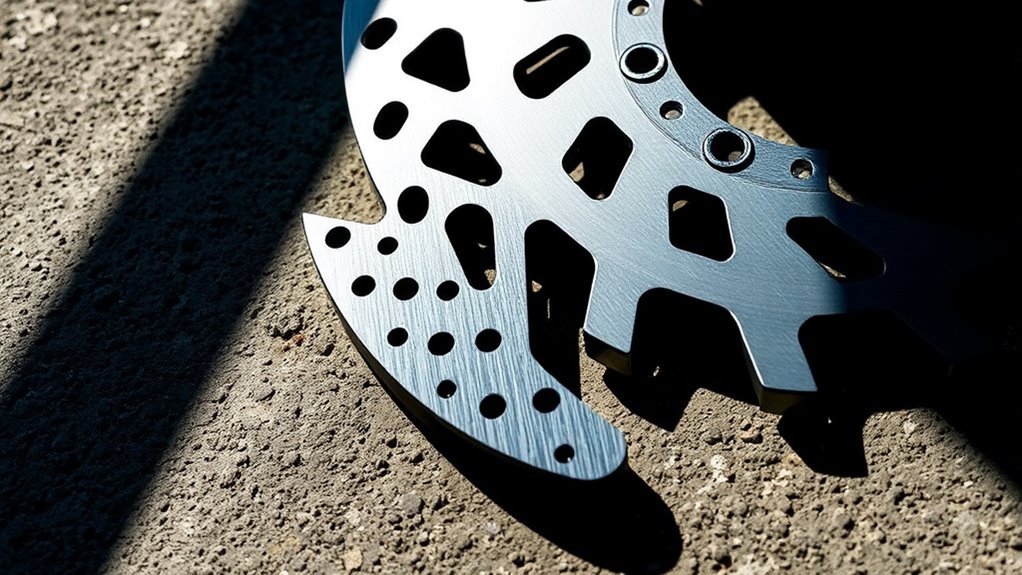
Maintaining drilled and slotted rotors can feel like a full-time job for car enthusiasts, and it’s no joke!
These rotors need frequent inspections to check for cracks and wear since they can wear unevenly and develop stress fractures. To keep them in top shape, regular cleaning is essential to clear away dust and debris—otherwise, both the rotors and brake pads might deteriorate quicker than a soda can in the sun!
Plus, the higher friction from slotted rotors often means more frequent brake pad replacements, adding to maintenance costs.
Don’t forget those squeaks and vibrations; they might require periodic adjustments to keep everything running smoothly.
Pro #7. Longer Lifespan Under Heavy Use
When it comes to heavy use, the lifespan of drilled and slotted rotors can be quite a mixed bag.
Drilled rotors, while great for performance, can crack under intense conditions, which shortens their lifespan. On the other hand, slotted rotors shine in this area! They reduce glazing and help with gas and dust evacuation, which means they can last longer during heavy braking.
Nevertheless, the combination of drilling and slotting can create added stress on the material, leading to quicker wear. For those pushing their brakes to the limits, regular maintenance is key to spotting cracks early.
In the end, if durability is the goal, blank rotors may just take the trophy for the longest lifespan under heavy use.
Con #7. Increased Risk of Rotor Warping
Drivers often find themselves in a bit of a pickle when it comes to drilled and slotted rotors, especially regarding the pesky issue of warping.
These rotors, while stylish, are more susceptible to warping due to their design, which has those little holes and slots that can create stress points during heavy braking.
When drivers push their luck with aggressive driving, the heat generated can really crank up the thermal expansion, making warping more likely than with good old blank rotors.
This warping can lead to uneven brake pad wear, which is like a recipe for disaster—reduced braking efficiency and longer stopping distances.
Pro #8. Improved Performance in Motorsports
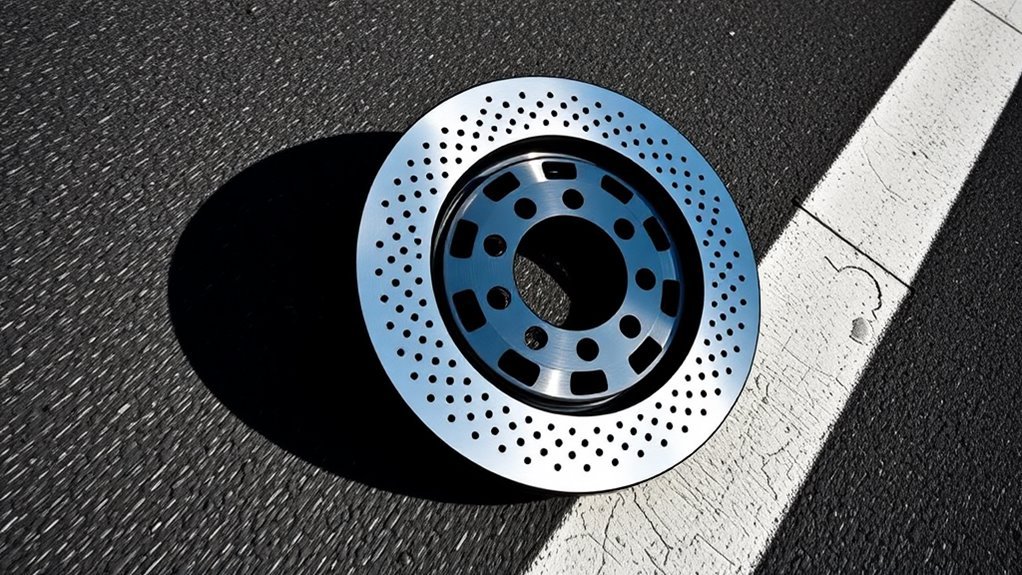
In the fast-paced world of motorsports, every detail counts, and that’s where drilled and slotted rotors really shine.
These rotors are designed to give racing vehicles an edge when it comes to braking power. The drilled holes help with better cooling, letting heat escape faster during those intense races.
Meanwhile, the slots improve the grip of brake pads, making sure drivers get a solid bite on the brakes. This combo not only stops cars more efficiently but also reduces brake fade, keeping racers in control when it counts.
High-performance models like BMW and Porsche often feature these rotors, proving that in the thrilling domain of racing, the right equipment can make all the difference.
Con #8. Increased Installation Complexity
Installing drilled and slotted rotors can feel a bit like assembling a jigsaw puzzle with a few extra pieces thrown in.
These rotors have unique designs that require precise installation techniques, making the process more complex than with standard rotors. The drilled holes and slots demand careful alignment to prevent misalignment issues, which could lead to uneven wear or reduced braking efficiency.
Plus, specialized tools may be necessary to guarantee a secure fit, increasing the labor involved. Mechanics need to handle these rotors with care to avoid stress risers that could crack under heavy use.
Finally, compatibility with specific brake pads is essential; mismatched components can complicate installation and hinder performance. It’s imperative to follow manufacturer recommendations closely!
Pro #9. Enhanced Performance for Racing Vehicles
While racing might seem all about speed and skill, the brakes play an essential role in keeping everything under control, especially when the rubber meets the road.
Drilled and slotted rotors are game-changers for racing vehicles. Those drilled holes? They’re not just for show; they help improve airflow, lowering the heat during those intense stops, which means less brake fade.
Slotted rotors kick in by clearing away gases and dust, giving drivers a more responsive feel when they hit the brakes.
Many high-performance cars, like BMWs and Porsches, utilize these designs to boost braking power.
This combination is perfect for both track racing and joyful spins on the road, ensuring reliability when the competition heats up.
Con #9. Increased Installation Difficulty
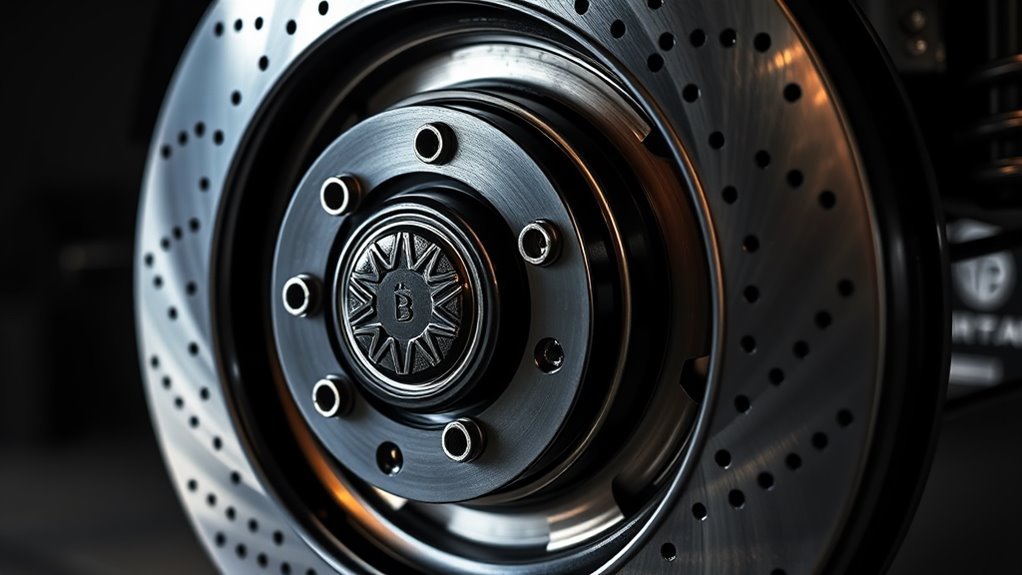
How tricky can installing drilled and slotted rotors really be? Well, it’s not as simple as just swapping out your old rotors.
These fancy brake components require precise installation because of their unique drilled holes and slots. If you’re not careful, you might accidentally damage them, which is a big no-no!
Plus, you may need special tools to get the job done right, adding to the complexity and time involved.
And don’t forget the bedding procedures—each manufacturer has their own guidelines for peak performance.
If the rotors don’t fit perfectly with other brake parts, it could lead to even more headaches.
Pro #10. Improved Performance Under Stress
When it comes to performance under stress, drilled and slotted rotors really shine like a star on a clear night.
Drilled holes give these rotors an edge by enhancing airflow, which cools them down and helps prevent brake fade during intense braking. Imagine speeding down the track, the heat builds up, but thanks to those nifty holes, the rotors stay cooler.
On the other hand, slotted rotors offer a fantastic way to clear away gas and dust from the braking surface, keeping the brake pads engaged for a solid grip.
Both types are perfect for heavy loads or thrilling off-road adventures.
Just remember, while they’re awesome, drilled rotors can crack under extreme pressure—so choose wisely!
Con #10. Historical Reliability Concerns
Even though drilled and slotted rotors have gained popularity among car enthusiasts for their performance perks, historical reliability concerns have cast a shadow on their reputation.
These rotors can sometimes be a bit temperamental, especially when it comes to developing stress cracks around the holes, particularly during heavy braking. This isn’t just a minor issue; it can compromise safety.
While slotted rotors generally hold up better, they can still face accelerated wear due to increased friction. Early designs struggled with heat dissipation, leading to brake fade, and let’s not forget that poor manufacturing can result in warping or cracking.
With inconsistent performance under extreme conditions, some drivers remain skeptical about using these rotors for everyday rides.
Past Rotor Design Flaws
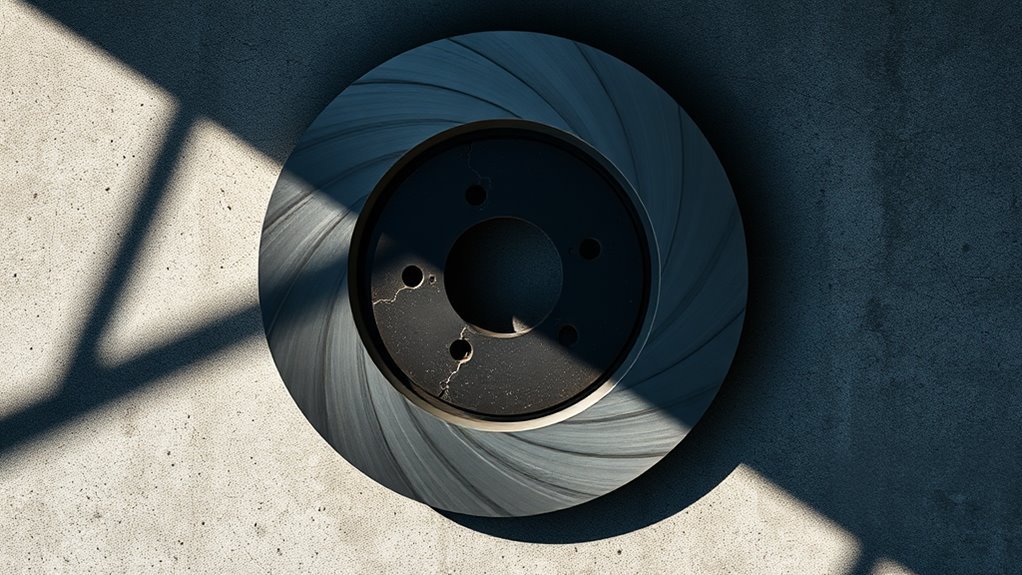
Rotors have come a long way, but the road to perfection was bumpy, to say the least. Early drilled rotor designs often cracked around the holes, thanks to not enough material thickness. This meant less durability when drivers hit the brakes hard.
On the other hand, slotted rotors weren’t winning any awards either; their aggressive slots led to noisy brakes and faster wear. Inconsistent machining made things worse, causing uneven surfaces that resulted in annoying vibrations.
Some drilled and slotted rotors even warped after a while, especially when exposed to extreme heat without cooling. It became clear that there was a fine line between ventilation and structural integrity, and early designs often stumbled on this vital balance.
Final Thoughts
Braking performance is a fascinating blend of engineering and physics, and the choice between drilled and slotted rotors can feel a bit like picking your favorite superhero.
Each type has its pros and cons, which can greatly influence better braking. Drilled rotors excel at heat management but may crack under pressure, while slotted rotors help with water evacuation but can wear down brake pads faster.
Both options shine in wet conditions and during intense driving, but they come with a higher price tag and more maintenance needs.
In the end, the decision should reflect one’s driving habits and vehicle use. Choosing wisely guarantees that every stop is smooth, safe, and superhero-worthy, making those thrilling drives even more enjoyable!
Resource
Design Optimization Method for Drilled and Slotted Brake Type Rotors: Discusses weight reduction without performance loss.
Drilled and Slotted Rotors: Pros, Cons, and Performance Insights: Analyzes benefits and drawbacks.
Which Brake Disc Should You Choose? Drilled or Slotted?: Compares performance advantages.
Drilled Rotors vs. Slotted Rotors: Engineer Test: Engineer’s comparative analysis.
Thermal Analysis of Drilled and Slotted Brake Rotors: Examines heat dissipation characteristics.
Design and Analysis of a Disc Brake Rotor for Optimal Performance: Studies various rotor designs.
Brake Fade: Explains causes and mitigation, including rotor design.
Disc Brake: Provides an overview of disc brake systems.

